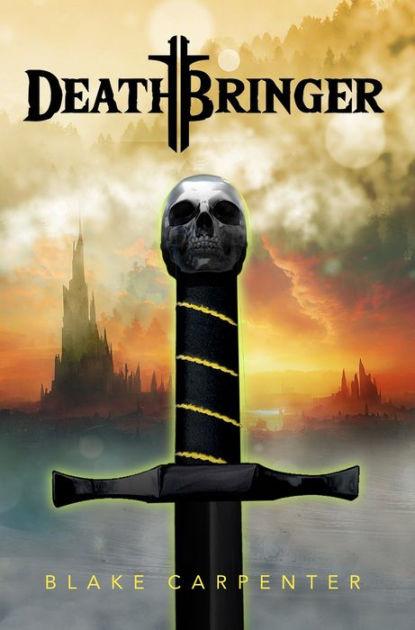You are here
Home › Books › Blake Carpenter's New Fantasy Novel 'Deathbringer' Is Fast-Moving Magical Entertainment ›Blake Carpenter's New Fantasy Novel 'Deathbringer' Is Fast-Moving Magical Entertainment
FTC Statement: Reviewers are frequently provided by the publisher/production company with a copy of the material being reviewed.The opinions published are solely those of the respective reviewers and may not reflect the opinions of CriticalBlast.com or its management.
As an Amazon Associate, we earn from qualifying purchases. (This is a legal requirement, as apparently some sites advertise for Amazon for free. Yes, that's sarcasm.)

'Heroic Fantasy’ is an umbrella term encompassing any number of adventurous subgenres that mix magic, myth and drama to one degree or other. With roots extending back to the Akkadian epic Gilgamesh in the 3rd century BCE, the tree of fantasy has since sprouted many divergent branches, from the seminal works of literary legends like Robert E. Howard, J.R.R. Tolkien and Michael Moorcock, to the escapist role-playing games of Dungeons & Dragons and the gritty, sex-and-horror infused variant known as grimdark.
The reasons for fantasy’s enduring popularity lie in the easily relatable Good-vs-Evil archetypes little seen in our messy, morally ambiguous real world: there’s a hero to root for, a villain to boo, a trustworthy best friend, a wise sage to guide the way, and (most of the time) a Happily-Ever-After ending. Perhaps more than any other type of fiction, fantasy embraces Big Themes: gods and goddesses, monsters and demons, dynastic power struggles, the rise and fall of empires—it’s the stuff of fairy tales, classic Greek tragedies and Shakespearean plays.
Author Blake Carpenter understands and explores those Big Themes in Deathbringer, an entertaining spin on traditional fantasy tropes. Young Inga Ivanova learns on her wedding day that she’s the rightful inheritor of the titular sword, a magical black blade that belonged to her ancestor, the ruthless despot Katarina Alenir, who ignited a world war trying to consolidate her clan’s power. Deathbringer—one of many named Spellswords forged in ancient times and infused with supernatural qualities—has the ability to raise the dead, which is exactly what happens after Inga, her groom-to-be Pytor and their entire wedding retinue are mercilessly slaughtered at the command of Yenda Avard, daughter of the rival Avardi clan’s matriarch, whose singular ambition is to gain control of as many Spellswords as possible. Inga is resurrected by Deathbringer’s energy and unwillingly bound to the weapon until the burgeoning full moon signals her second, final demise. Determined to spend that time avenging her fallen family, she first hunts down Kale Isrodel, Yenda’s intended husband and Inga’s own murderer; claiming he has reason for loathing his betrothed, however, Kale surprises Inga by vowing to aid her vengeful quest and together they embark on a harrowing journey to the fortress city of Whitehold to kill Yenda and reclaim Inga’s birthright. But can Kale be trusted? And can Inga overcome the mountain of obstacles in her search for revenge?
There’s no shortage of old-fashioned pulpy fun in Deathbringer—swordplay, fisticuffs, captures, escapes, secret passageways, mystery, intrigue, sorcery, betrayal—it’s all here, along with vibrant characterization, smooth prose and a well-tended plot ripe with unexpected twists, lively dialogue and a delightful dollop of humor. As a protagonist, Inga is a capable female lead who never slumps into the tired Badass Warrior Woman cliché; her inner emotional landscape brews with despair and self-doubt, longing for the future so abruptly stolen and unknowing if she’s strong enough to complete the brutal task thrust upon her. It’s a realistic, believable stance, one buttressed by Kale’s narrative presence; Carpenter takes a bold chance by not only making Inga’s murderer a sympathetic figure, but eventually turning him into an invaluable, if unconventional, sidekick in her pursuit of retribution.
One of Deathbringer’s central attributes is the lack of dense over-explanation; fantasy is oft-fond of the exposition dump, but it’s to Carpenter’s credit that the details of his imaginary world come through conversation and action rather than impenetrable blocks of dull history-class description. As with most sword-and-sorcery, though, the efforts of previous genre titans reveal themselves in certain concepts, a fact Carpenter acknowledges in his author’s note: the idea of mystically-endowed swords can be traced directly to the aforementioned Moorcock, whose Elric of Melniboné struggled against the soul-eating Stormbringer, an idea elaborated on in Fred Saberhagen’s multi-volume Book of Swords epic. This isn’t to imply Carpenter is some literary thief—all artists, regardless of medium, are the sum of their creative consumption; the trick is to add one’s individual views, opinions and life experiences to those influences, and the thoughtful world-building in Deathbringer proves how much time the author invested doing just that. The result is most readily seen in the story’s relationship with technology: unlike so many fantasy excursions, Deathbringer isn’t wholly set in some faux-medieval Never-Neverland; Inga’s world of Agareth is plainly analogous to the mid-nineteenth century, complete with trains, rifles, revolvers and the foundries and factories of the early industrial revolution, with an in-built societal structure reminiscent of the classic American Western. High Plains Drifter with swords and magic.
Fast-moving, well-written and thoroughly engaging, Deathbringer brings originality and excitement to a sometimes stale genre, and it’s for that reason that I give it a resounding 4 (out of 5) on my Fang Scale. I hope the implications at the novel’s conclusion that a sequel awaits are true.


